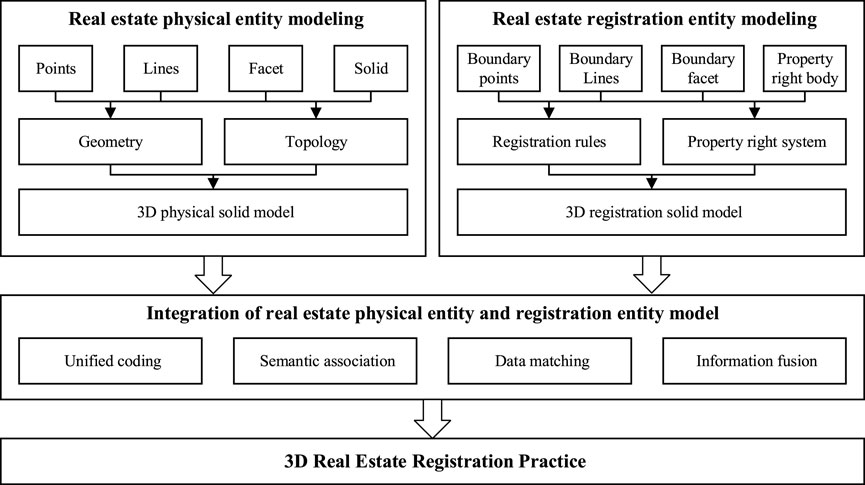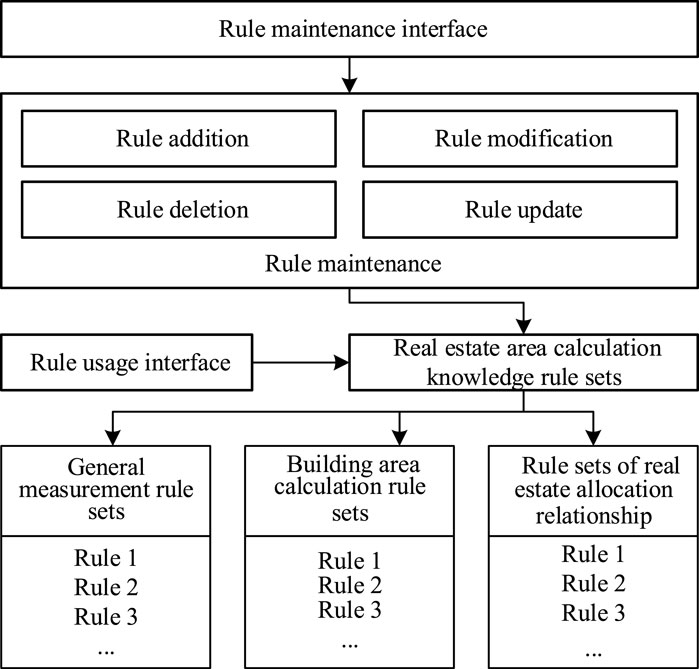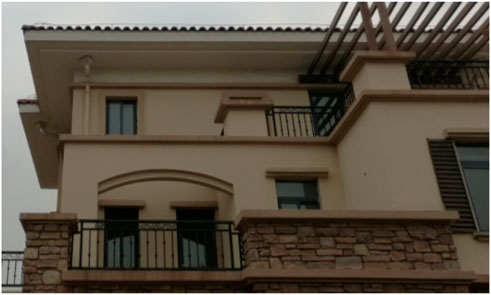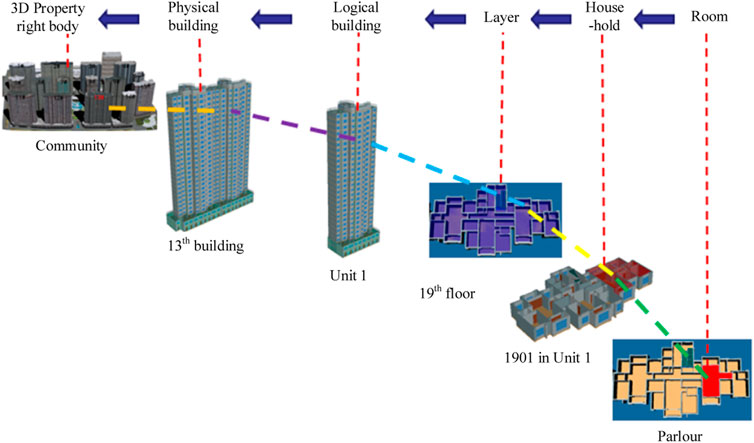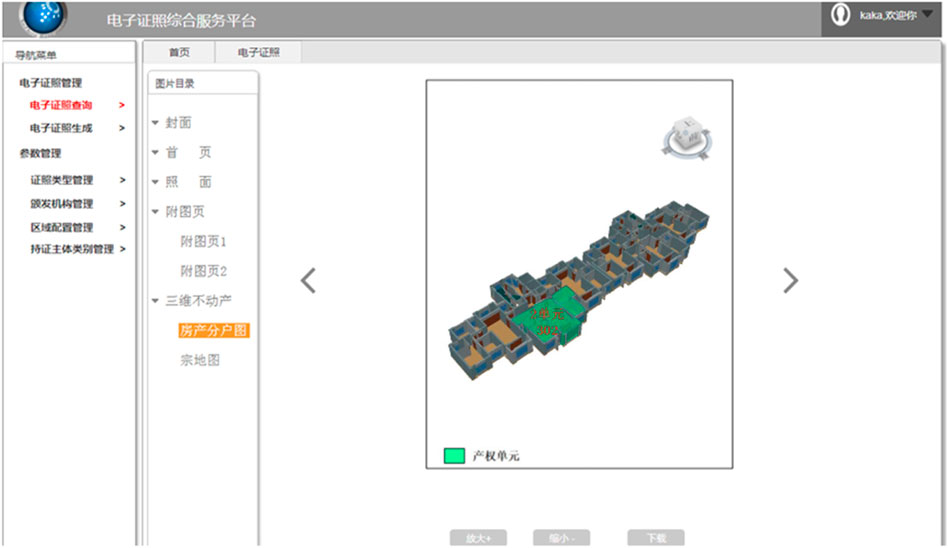- 1College of Geographic Sciences, Nantong University, Nantong, China
- 2Key Laboratory of Spatial Information Technology Spatial Information Technology R&D and Application, Nantong University, Nantong, China
- 3School of Geographic Information and Tourism, Chuzhou University, Chuzhou, China
- 4Jiangsu Yangtze River Economic Belt Research Institute, Nantong, China
- 5Xinyi Natural Resources and Planning Bureau, Xuzhou, China
- 6School of Geography, Nanjing Normal University, Nanjing, China
The essence of three-dimensional (3D) real estate modeling is to build a 3D model that meets the requirements of the registration business in the information world according to the objective form of real estate objects and relevant legal provisions on real estate registration. It is the application of digital twin technologies in the field of real estate registration. In recent years, scholars have carried out much research and made a number of representative achievements in the field of 3D real estate modeling. Many countries and regions have started to implement 3D real estate registration. However, different countries have different legal provisions on real estate registration. Compared with other countries and regions in the world that have implemented 3D real estate registration, China’s 3D real estate registration is still in the exploratory stage. Although Chinese scholars have conducted much research from the perspectives of the 3D real estate registration mode, modeling method, legal framework, etc., existing studies mainly focus on the geometric modeling of physical entities and ignore the research on integrated modeling of physical entities and property right entities of real estate objects. Meanwhile, existing research results lack a combination with real estate registration practice. This research is one of the core contents of the pilot construction of Xinyi City’s two-dimensional (2D) and 3D integrated real estate electronic license registration. Combined with the real estate registration business practice in Xinyi City, this paper has developed a multilevel 3D real estate property rights modeling technology that integrates the physical entities and property right entities of the real estate registration object. The research results were applied to the real estate registration management of Xinyi City, supporting the issuance of the first 2D and 3D integrated real estate registration electronic license in Jiangsu.
1 Introduction
With the increasing pressure of land supply in urban areas, 3D space development has become one of the main ways to improve the efficiency of land use, leading to increasingly complex buildings. The transformation of land development and utilization from 2D to 3D, forming a complex three-dimensional spatial structure, has led to the superposition of cadastral rights belonging to different right subjects in vertical direction (Stoter and Salzmann, 2003; Ying et al., 2021). The cadastral management model based on 2D parcel cannot accurately describe the complex property rights distribution structure in 3D space. It is often led to property rights disputes caused by unclear property rights registration (Shojaei et al., 2016; Hanus et al., 2018). It is urgent to develop a 3D cadastral management model to prepare and describe the distribution of rights in 3D space (Benhamu and Doytsher, 2003; Guo et al., 2013; Yu et al., 2017; Jaljolie et al., 2018; Navratil et al., 2018; Li et al., 2019).
Different from urban 3D modeling, 3D cadastral modeling should not only consider the physical form of the registered object, but also comply with the relevant legal provisions of cadastral registration (Stoter and Oosterom, 2005; Kalantari et al., 2008; Karki et al., 2013; Lee et al., 2015; Shojaei et al., 2016). The integrated modeling of physical entities and property right entity of 3D cadastral registration object is the basis for the development of 3D cadastral registration (van Oosterom et al., 2006; Thompson and Oosterom, 2011). The current research on 3D cadastral registration object modeling technology focuses on the following two aspects: 1. Research on integrated modeling method of physical entity and property right entity of 3D cadastral registration object (Aien et al., 2013; Ding et al., 2017; Wang et al., 2014; Wu et al., 2016; Zulkifli et al., 2021; ISO TC211, 2012; Zhou et al., 2021), 2. Research on 3D cadastral property rights modeling based on BIM, CityGML, IFC, and other data sources (Atazadeh et al., 2018; Gkeli et al., 2021a; Radulović et al., 2021; Shin et al., 2022). Limited by the registration system and legal framework, there are significant differences in the integrated modeling methods of physical entities and property rights entities of 3D cadastral registration objects in different countries and regions (Guo et al., 2012; Drobež et al., 2017; Aditya et al., 2021; Zulkifli et al., 2021). For example, institutional differences in public property rights, land ownership and use rights in different countries will inevitably lead to different cadastral registration systems, which will correspondingly affect the modeling method of 3D cadastral registration objects. One of the challenges in developing 3D cadastral registration is how to establish corresponding 3D cadastral modeling models for specific 3D cadastral registration needs. Another challenge for the development of three-dimensional cadastral is how to obtain sufficient three-dimensional cadastral data. Cadastral registration is the confirmation of certain rights of specific obliges according to relevant laws, and the registration result has certain legal effect. Therefore, the accuracy and authority of cadastral data are the basis of cadastral registration. In recent years, many scholars have tried to establish the conversion relationship between BIM, CityGML, IFC and other data sources and 3D cadastral modeling (Gkeli and Potsiou, 2021b; Sun et al., 2021; Sürmeneli et al., 2021; Yam et al., 2021). These research enriches the 3D cadastral data source and modeling method of 3D cadastre. However, the acquisition cost of the above format data is high. There are often few real estate buildings that meet the above data organization standards. In summary, there are still many problems to be solved in the development of 3D cadastral, such as modeling data source and meeting specific registration requirements.
Multilevel building property right registration is one of the subjects of China’s 3D cadastral registration. In China’s multilevel property right registration system, the area of real estate purchased by property owner includes the available indoor area and the area of community property allocated in proportion. The common property of the community involved in the sharing includes stairs (elevators), building exterior walls, community public facilities, etc., Different types of common property often have different calculation coefficients of shared area. The shared area of each real estate property right is expressed by a number in 2D cadastral registration. The obligee is unable to know which public property is shared and how to calculate the shared area. This ambiguous way of property area registration has caused a large number of property rights disputes.
In view of general lack of BIM or IFC format data in China’s multilevel buildings and the demand for 3D registration of common area of multilevel buildings, this paper proposes a 3D real estate physical entity and registration entity integration modeling method based on construction drawings. The real estate construction drawing approved by the cadastral authority is used as the modeling data source. A three-dimensional property right model for multilevel buildings is constructed based on the current technical regulations for real estate area measurement in Jiangsu Province. The research results of this paper are applied to the pilot building of the electronic real estate license registration in Xinyi City. It provides modeling technical support for the issuance of the first two-dimensional and three-dimensional integrated real estate registration electronic license in Jiangsu.
2 Basic ideas
The purpose of 3D real estate modeling research is to promote the development and realization of 3D real estate registration and management (Stoter and Salzmann, 2003; Thompson and Oosterom, 2011). Existing 3D real estate modeling and registration research has made fruitful research results from the perspectives of geometric and topological relationship modeling of real estate physical entities, construction of real estate registration entities and property rights abstraction. It provides solid technical support for the development of 3D real estate registration management.
Take the construction drawing as the data source, this paper focuses on the construction method of real estate property right model in multilevel buildings. The boundary of 3D real estate property rights is based on the boundary information in the construction drawings. The division of common properties and their 3D spatial distribution is one of the key contents of property rights modeling. The integration method of real estate physical entities and registration entities is studied from the perspective of practical application of real estate registration business. The overall technical roadmap of this study is shown in Figure 1. It can be divided into four parts: real estate physical entity modeling, real estate registration entity modeling, physical entity and registration entity integration, and 3D real estate registration business application.
3 Methodologies
3.1 Modeling method of 3D real estate physical entities
The data acquisition method and information integrity of 3D real estate modeling play an important role in 3D real estate modeling. According to different real estate data acquisition methods, the main 3D real estate modeling methods include manual modeling, photogrammetric modeling, real estate mapping modeling, and building construction drawing modeling. The manual modeling method uses 3D modeling software to create 3D models. This method has many problems, such as an excessively large amount of modeling and costs that are too high and too long, which makes it difficult to meet the requirements of large-scale modeling of real estate. The photogrammetric modeling method can directly obtain the 3D surface model data of real buildings. It needs to take real buildings as the modeling object, which is not consistent with the modeling task at that stage of real estate prediction. The modeling based on real estate surveying and mapping data is generally based on the boundary points, lines and objects in the parcel map or house property hierarchical and household map. However, the real estate surveying and mapping data do not include building entities such as doors, windows, roofs and indoor spaces, which destroy the structure of entities such as walls, bay windows and balconies, and cannot accurately express the real structure of the real estate. The modeling method based on construction drawings is represented by the information extraction of real estate from built drawings of architectural design and construction. The 3D model of the building is obtained by processing and analyzing the extracted information. However, this method tends to define the elements in the field of building structure, and does not consider the management information of 3D real estate, which makes it difficult to effectively support the calculation and analysis of registration information and the expression of property relations.
Compared with other data sources, the computer-aided design (CAD) data of real estate construction completion drawings of real estate registration management departments are modeling data recognized by the government with high data quality reliability. It contains much real estate geometric structure information and is a suitable data source for 3D modeling of real estate. Although there is a lack of 3D real estate ownership information, it can better meet the needs of real estate physical entity modeling. Therefore, 2D built drawings in the CAD format provided by the Xinyi Real Estate Registration and Management Department are used as the main data source for 3D modeling of real estate physical entities in this paper.
The technical roadmap for 3D physical entity modeling of real estate in this paper is shown in Figure 2. Due to the architectural construction drawings formed in different periods, there are great differences in the drawing annotation and element annotation formats. As a result, it is necessary to standardize the modeling data through CAD drawing data review and data verification before modeling. On this basis, the building components, building spaces and building relationships of real estate are analyzed, identified and extracted from CAD design data. The parametric modeling method is used to automatically construct the model of geometric components, building space, and topological relations. Finally, the 3D physical entity model of real estate that meets the registration requirements of the real estate management department is constructed using the real estate building component relational database.
3.2 Modeling method of 3D real estate registration entities
The ownership scope of real estate registration objects should not only consider the physical form of the registration object, but also comprehensively consider the relevant legal provisions of real estate registration. The physical object of real estate reflects only the objective geometric shape, which is the objective basis for the registration of real estate ownership. However, real estate registration also needs to register the ownership and scope of the rights of the real estate accessories stipulated in the relevant laws of real estate registration. The construction of a 3D real estate registration entity according to relevant laws and regulations on real estate registration is the premise of 3D real estate registration.
Based on the pilot project of real estate registration in Xinyi City, this paper constructs the core class diagram of real estate registration objects as shown in Figure 3. In the process of the registration pilot, relevant laws and regulations related to 3D real estate rights were identified. The rights set supporting 3D real estate registration is constructed. The real estate rights subcategory is constructed according to the real estate registration characteristics, providing a basis for the construction of real estate registration objects and the calculation of relevant property areas.
The area of real estate is the core interest of property owners. Accurately calculating and splitting the relevant area of real estate is one of the key contents to be solved in the process of real estate registration. In the relevant Chinese regulations on real estate area calculation, the registered area of real estate includes the area that can be actually used by the property owners and the shared area of the public area in the entire community. The allocation proportion and calculation method of the public area of real estate have always been the focus of the real estate property owners. In the traditional 2D real estate registration process, the shared area of the public area is often just an abstract result figure. Because it is impossible to tell the property owner which public area has been allocated, it is very easy to cause various ownership disputes. Solving the problem of 3D displays of public area allocation is one of the core tasks of 3D modeling of real estate registration objects in the process of building 3D models of real estate registration entities.
The interpretation of Jiangsu Province’s Technical Regulations on Housing Area Measurement is the main basis for building the legal entity of the real estate registration object in the process of modeling the legal entity of real estate registration. The real estate property area calculation rules including property area calculation types, area calculation rules for different property types and shared area calculation rules are constructed based on the real estate property area measurement business practice of the Xinyi Real Estate Registration Center (Figure 4). The calculation types of the real estate property area include calculations of the total building area, half the building area and no building area. In the actual modeling process, the specific calculation type needs to be determined in combination with different property rights. The shared area of real estate is one of the indicators closely related to the interests of property owners. The calculation rule system of shared areas, including the classification of shared building areas, the sharing principle of shared building areas, the calculation method of sharing coefficients and the sharing method of special shared building areas, is established to accurately calculate the shared area of 3D real estate property rights. The area calculation rules of different property types are subdivided. The area calculation rules of 10 different types of property rights, including balcony, pipe shaft, stairwell, porch, bay window and air conditioning machine room, are constructed. According to 3D real estate area calculation rules and other legal rights related to real estate registration, a 3D model of real estate registration entities is constructed (Figure 5). It solves the problem that the traditional 2D real estate registration cannot accurately express the spatial distribution of the shared area.
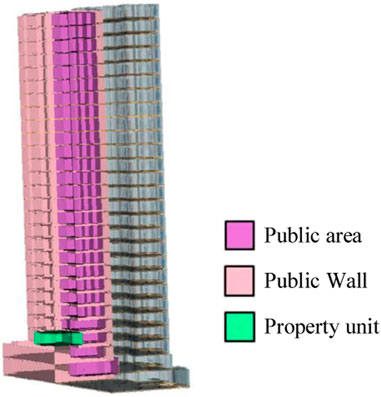
FIGURE 5. The legal entity model of the real estate registration object and the spatial distribution diagram of the property right sharing area.
3.3 Integration method of 3D real estate physical entity and registered entity
One of the core tasks of 3D real estate registration is to accurately describe the scope and ownership of real estate rights. The physical entity of the real estate registration object determines its spatial position, geometric form and other information. The ownership boundary information needs to be determined based on physical entities and the relevant legal provisions of real estate registration. Taking the determination of the ownership boundary of the open balcony as an example, although there is no wall restriction on the top of the open balcony, the relevant rights of the upper property owner cannot be affected in the actual use process (Figure 6). Therefore, the top boundary of the open balcony needs to be determined according to the relevant laws and regulations of real estate. The integration of 3D physical entities and property right entities of real estate objects into one registration object is the basis for 3D real estate registration.
On the basis of 3D modeling of the physical entity and legal entity of real estate registration object, we have built an integrated multilevel 3D real estate property rights model of Room-House-Floor-Logical building-Natural building-Parcel (RHFLNP) integrating the physical entity and legal entity of the real estate registration object (Figure 7). The construction drawing data will be standardized first in the process of 3D modeling of physical entities of real estate registration objects. The geometric and topological information of building components and building spaces is extracted from the standardized building construction CAD drawings. Through the analysis and extraction of the adjacency, connectivity, aggregation and other relationships of the building space, the building space expansion algorithm is designed to realize the conversion of the real estate room space to the real estate household space. Finally, the building space in the physical entity model is directly associated with the room unit in the multilevel real estate property rights model through the unified code of real estate registration. Rights, areas, attributes, semantics, relationships and other information needed to build the legal entity of the registered object are extracted from the real estate registration materials in the process of 3D modeling of the legal entity of the real estate registration object. The real estate property area is calculated based on the 3D real estate property area calculation rules and the real estate area information extracted from the construction drawings. The real estate relationship and real estate area in the legal entity model of the registered object are constructed based on the complete property right unit applied for registration. Finally, the legal entity of the real estate registration object is associated with the household unit in the multilevel real estate property rights model through the unified code of real estate registration. Finally, the physical entity and legal entity of the real estate registration object are integrated into the integrated multilevel property rights model consisting of parcels, natural buildings, logical buildings, floors, households and rooms (Figure 8).
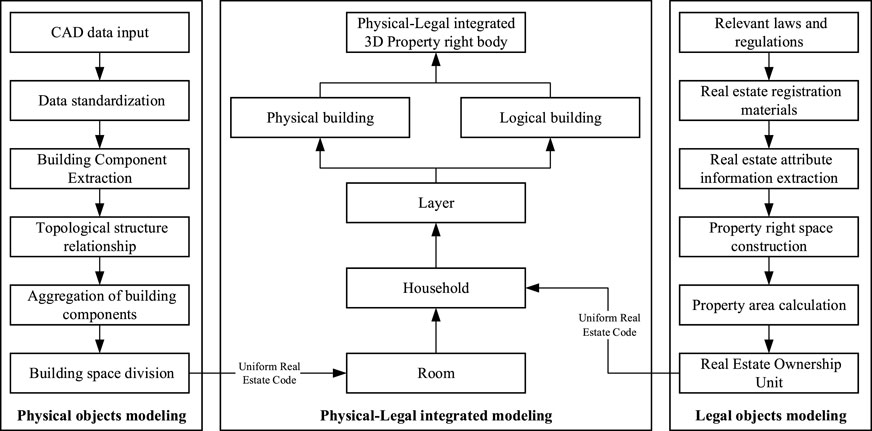
FIGURE 7. Roadmap of real estate multi-level property model integrating physical and legal information.
4 Case studies
This research is one of the core contents of the pilot construction of 3D real estate electronic license registration in Xinyi City. The pilot was initiated by the Ministry of Natural Resources to promote the development of China’s 3D cadastral registration. This paper takes the real estate registration business of a community including 21 multilevel buildings in Xinyi City as an example (Figure 9). The integrated multilevel 3D real estate property rights modeling technology of RHFLNP integrating the physical entity and legal entity of the real estate registration object was applied and verified. The application results show that the multilevel 3D real estate property rights modeling technology integrating the physical entity and legal entity of the real estate registration object developed in this paper can provide an accurate 3D real estate registration model for real estate registration management departments. The research results support the 3D real estate registration business (Figure 10). The multilevel 3D real estate model integrating the physical entity and legal entity of the real estate registration object can be used to realize the 3D dynamic query of the property rights registration unit space. At the same time, it can further clarify the scope of real estate rights in 3D space by accurately querying the spatial distribution and allocation proportion of the public area allocated by the current property rights registration unit in the entire community.
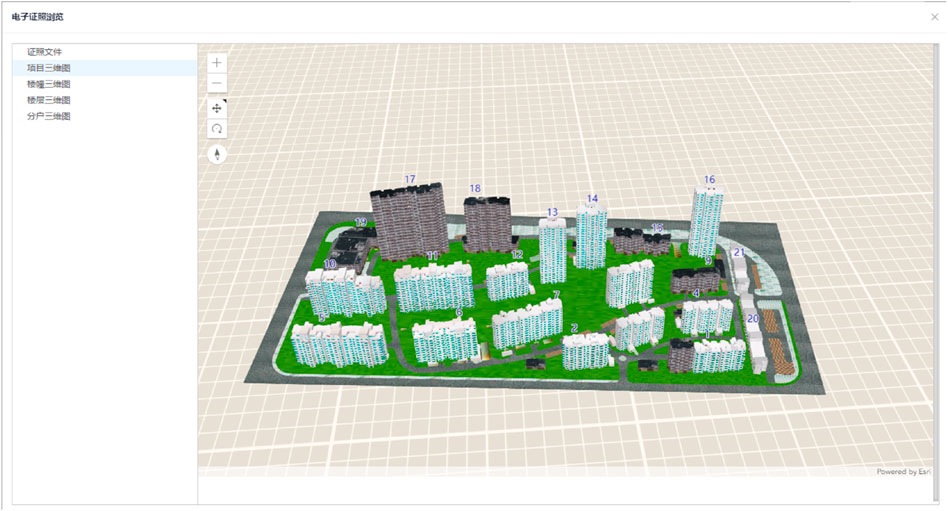
FIGURE 9. Schematic diagram of the experimental plot for the research results of integrated modeling of physical entity and legal entity of real estate registration object.
5 Conclusion and discussion
Based on the pilot project of the Ministry of Natural Resources of China in Xinyi City, Jiangsu Province, for the 2D and 3D integration of real estate electronic license registration, this paper aims at the problems such as the lack of integration of physical entities and property right entities in the current research on 3D modeling of real estate, and the lack of integration of research results with the registration business practice. The standardization processing and automatic modeling technology of 3D real estate physical entity data based on construction drawings are proposed, and the construction method of the 3D legal entity of registration object based on relevant laws and regulations of real estate is constructed. On this basis, the integrated multilevel 3D real estate property rights modeling technology of RHFLNP integrating physical entities and legal entity entities of real estate registration objects is developed. This research is one of the core contents of Xinyi’s pilot project of 2D and 3D integration of real estate electronic license registration. The research results are directly applied to the real estate registration department of Xinyi City, meeting the requirements of the real estate registration management department for modeling and managing 3D real estate registration data. The research results provide technical support for Xinyi real estate registration department to issue the first 2D and 3D integrated real estate registration electronic license in Jiangsu Province.
The integrated modeling method of real estate physical entities and registration entities based on the construction drawing data of multilevel buildings proposed in this paper can clearly show the proportion and spatial distribution of common property area. It can meet the 3D registration requirements of the common area of multilevel buildings and help reduce relative property rights disputes. In the absence of BIM or IFC standard format data for most multilevel buildings, the 3D real estate modeling and registration method proposed in this paper provides a new way to solve the problem of lack of 3D cadastral modeling data source. However, the calculation methods of common property allocation in different regions are different, which hinders the promotion of the modeling method proposed in this paper. It is necessary for government departments to unify the calculation methods of common property allocation from the registration system level. (Shojaei et al., 2017).
Data availability statement
The data analyzed in this study is subject to the following licenses/restrictions: The data in this paper is mainly the real estate archive data provided by the government department, which is not convenient for public disclosure. Requests to access these datasets should be directed to Jiyi Zhang, WmhhbmdqaXlpQG50dS5lZHUuY24=.
Author contributions
Conceptualization, JZ, LZ, and ZS; methodology, JZ and FY; writing—original draft preparation, CZ and JZ; writing—review and editing, JZ and LZ; visualization, LZ and CZ. All authors have read and agreed to the published version of the manuscript.
Funding
This study was financially supported by the National Natural Science Foundation of China (42001325 and 42001322), and Natural Science Foundation of Anhui Province, China (grant number 2008085QD168).
Conflict of interest
The authors declare that the research was conducted in the absence of any commercial or financial relationships that could be construed as a potential conflict of interest.
Publisher’s note
All claims expressed in this article are solely those of the authors and do not necessarily represent those of their affiliated organizations, or those of the publisher, the editors and the reviewers. Any product that may be evaluated in this article, or claim that may be made by its manufacturer, is not guaranteed or endorsed by the publisher.
References
Aditya, T., Laksono, D. P., Atunggal, D., Susanta, F., Widjajanti, N., Setiawan, M. B., et al. (2021). “3D modelling, validation and visualization of 3D parcels in first registration for 3D cadastre – indonisia case,” in 7th International FIG 3D Cadastre Workshop, New York, NY, USA.
Aien, A., Kalantari, M., Rajabifard, A., Williamson, I., and Wallace, J. (2013). Towards integration of 3D legal and physical objects in cadastral data models. Land Use Policy 35, 140–154. doi:10.1016/j.landusepol.2013.05.014
Atazadeh, B., Rajabifard, A., Kalantari, M., and Shin, J. (2018). “A BIM-driven approach to managing common properties within multi-owned developments,” in 6th International FIG 3D Cadastre Workshop, Delft, The Netherlands.
Benhamu, M., and Doytsher, Y. (2003). Toward a spatial 3d cadastre in Israel. Comput. Environ. Urban Syst. 27, 359–374. doi:10.1016/s0198-9715(02)00036-4
Ding, Y., Jiang, N., Yu, Z., Ma, B., Shi, G., and Wu, C. (2017). Extrusion approach based on non-overlapping footprints (EABNOF) for the construction of geometric models and topologies in 3D cadasters. ISPRS Int. J. Geo Inf. 6, 232. doi:10.3390/ijgi6080232
Drobež, P., Fras, M. K., Ferlan, M., and Lisec, A. (2017). Transition from 2d to 3d real property cadastre: The case of the slovenian cadastre. Comput. Environ. Urban Syst. 62, 125–135. doi:10.1016/j.compenvurbsys.2016.11.002
Gkeli, M., Potsiou, C., and Ioannidis, C. (2021). BIM data as input to 3D crowdsourced cadastral surveying - potential and perspectives. Netherlands: FIG e-Working Week 2021.
Gkeli, M., and Potsiou, C. (2021). “Linking LADM with BIM/IFC standards for mobile-based 3D crowdsourced cadastral surveys,” in 7th International FIG 3D Cadastre Workshop (New York, NY, USA.
Guo, R. Z., Li, L., Ying, S., Luo, P., He, B., and Jiang, R. R. (2013). Developing a 3D cadastre for the administration of urban land use: A case study of shenzhen, China. Comput. Environ. Urban Syst. 40, 46–55. doi:10.1016/j.compenvurbsys.2012.07.006
Guo, R. Z., Yu, C. B., He, B., Zhao, Z. G., Li, L., and Ying, S. (2012). “Logical design and implementation of the data model for 3D cadastre in China,” in 3rd International Workshop on 3D Cadastres: Developments and Practices, Shenzhen, China.
Hanus, P., Pęska-Siwik, A., and Szewczyk, R. (2018). Spatial analysis of the accuracy of the cadastral parcel boundaries. Comput. Electron. Agric. 144, 9–15. doi:10.1016/j.compag.2017.11.031
ISO TC211 (2012). ISO 19152 geographic information - land administration domain model (LADM). Geneva, Switzerland.
Jaljolie, R., van Oosterom, P., and Dalyot, S. (2018). Spatial data structure and functionalities for 3D land management system implementation: Israel case study. ISPRS Int. J. Geo Inf. 7, 10. doi:10.3390/ijgi7010010
Kalantari, M., Rajabifard, A., Wallace, J., and Williamson, I. (2008). Spatially referenced legal property objects. Land Use Policy 25, 173–181. doi:10.1016/j.landusepol.2007.04.004
Karki, S., Thompson, R., and McDougall, K. (2013). Development of validation rules to support digital lodgement of 3D cadastral plans. Comput. Environ. Urban Syst. 40, 34–45. doi:10.1016/j.compenvurbsys.2012.10.007
Lee, B. M., Kim, T. J., Kwak, B. M., Lee, Y., and Choi, J. (2015). Improvement of the Korean LADM country profile to build a 3d cadastre model. Land Use Policy 49, 660–667. doi:10.1016/j.landusepol.2015.10.012
Li, L., Lei, Y., Tang, L., Yan, F., Luo, F., and Zhu, H. H. (2019). A 3D spatial data model of the solar rights associated with individual residential properties. Comput. Environ. Urban Syst. 74, 88–99. doi:10.1016/j.compenvurbsys.2018.12.003
Navratil, G., Schwai, M., Vollnhofer, S., Konturek, P., and Giannopoulos, I. (2018). “From floor plans to condominium rights through an augmented reality approach,” in 6th International FIG 3D Cadastre Workshop, Delft, The Netherlands.
Radulović, A., Sladić, D., Govedarica, M., and Raičević, D. (2021). “LADM based taxation model in Montenegro: Using BIM in taxation process,” in 7th International FIG 3D Cadastre Workshop, New York, NY, USA.
Shin, J., Rajabifard, A., Kalantari, M., and Atazadeh, B. (2022). A BIM-based framework for property dispute minimization – a case study for Victoria, Australia. Land Use Policy 119, 106200. doi:10.1016/j.landusepol.2022.106200
Shojaei, D., Olfat, H., Faundez, S. I. Q., Kalantari, M., Rajabifard, A., and Briffa, M. (2017). Geometrical data validation in 3D digital cadastre − A case study for Victoria, Australia. Land Use Policy 68, 638–648. doi:10.1016/j.landusepol.2017.08.031
Shojaei, D., Olfat, H., Rajabifard, A., Darvill, A., and Briffa, M. (2016). Assessment of the Australian digital cadastre protocol (ePlan) in terms of supporting 3D building subdivisions. Land Use Policy 56, 112–124. doi:10.1016/j.landusepol.2016.05.002
Stoter, J. E., and Oosterom, P. (2005). Technological aspects of a full 3D cadastral registration. Int. J. Geogr. Inf. Sci. 19, 669–696. doi:10.1080/13658810500106042
Stoter, J., and Salzmann, M. (2003). Towards a 3d cadastre: Where do cadastral needs and technical possibilities meet? Comput. Environ. Urban Syst. 27, 395–410. doi:10.1016/s0198-9715(02)00039-x
Sun, J., Paasch, J., Paulsson, J., Tarandi, V., and Harrie, L. (2021). “Towards design and development of a BIM-based 3D property formation process,” in 7th International FIG 3D Cadastre Workshop, New York, NY, USA.
Sürmeneli, H. G., Koeva, M., and Alkan, M. (2021). “Integration of LADM and CityGML for 3D cadastre of Turkey,” in 7th International FIG 3D Cadastre Workshop, New York, NY, USA.
Thompson, R., and Oosterom, P. “Axiomatic definition of valid 3D parcels, potentially in a space partition,” in Proceedings of the 2nd International Workshop on 3D Cadastres, Delft, The Netherlands, November 2011.
van Oosterom, P., Lemmen, C., Ingvarsson, T., van der Molen, P., Ploeger, H., Quak, W., et al. (2006). The core cadastral domain model. Comput. Environ. Urban Syst. 30, 627–660. doi:10.1016/j.compenvurbsys.2005.12.002
Wang, L., Sun, Z., Qu, X., and Wu, C. (2014). Study on the data model and spatio-temporal relation of 3D cadastre. J. China Land Sci. 28, 39–45.
Wu, C. B., Yu, X., Ding, Y., Zhou, X. X., and Ma, B. Q. (2016). Construction of convex hull for three-dimensional data model of real estate unit. J. Computer-Aided Des. Comput. Graph. 28 (10), 1654–1661.
Yam, N., Kam, C., and Song, M. (2021). Development of the BIM data repository of lands department. Netherlands: FIG e-Working Week 2021.
Ying, S., Sum, H., Li, C., Zhang, W., Zhan, Y., Zhang, Y., et al. (2021). “Case-driven category analysis of 3D building property,” in 7th International FIG 3D Cadastre Workshop, New York, NY, USA.
Yu, C. B., Li, L., He, B., Zhao, Z. G., and Li, X. M. (2017). LADM-based modeling of the unified registration of immovable property in China. Land Use Policy 64, 292–306. doi:10.1016/j.landusepol.2017.02.034
Zhou, L. C., Wang, P. X., Chen, B., Wu, M. J., and Lv, G. N. (2021). 3D real estate data models of land and housing integration. J. Geo-information Sci. 23 (1), 143–154.
Keywords: real estate, 3D modeling, physical object, legal object, real estate registration
Citation: Zhang J, Yang F, Shi Z, Zhang C and Zhou L (2023) Research on real estate 3D modeling based on integration of physical entity and property entity. Front. Earth Sci. 10:1106077. doi: 10.3389/feart.2022.1106077
Received: 23 November 2022; Accepted: 19 December 2022;
Published: 04 January 2023.
Edited by:
Guiming Zhang, University of Denver, United StatesReviewed by:
Behnam Atazadeh, The University of Melbourne, AustraliaYuan Ding, Hohai University, China
Copyright © 2023 Zhang, Yang, Shi, Zhang and Zhou. This is an open-access article distributed under the terms of the Creative Commons Attribution License (CC BY). The use, distribution or reproduction in other forums is permitted, provided the original author(s) and the copyright owner(s) are credited and that the original publication in this journal is cited, in accordance with accepted academic practice. No use, distribution or reproduction is permitted which does not comply with these terms.
*Correspondence: Liangchen Zhou, emhvdWxjaEBuam51LmVkdS5jbg==
 Jiyi Zhang
Jiyi Zhang Fan Yang1,2,4
Fan Yang1,2,4 Liangchen Zhou
Liangchen Zhou